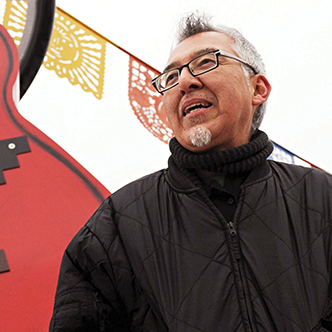Request Information
Ready to find out what MSU Denver can do for you? We’ve got you covered.
 Carlos Fresquez was a student in the brand-new art room on the brand-new Auraria Campus when the first splash of paint hit the floor.
Carlos Fresquez was a student in the brand-new art room on the brand-new Auraria Campus when the first splash of paint hit the floor.
“I remember when it happened and we all looked up at the instructor like, ‘What is he going to do?’ Today, that floor looks like a Jackson Pollock painting. I feel like a part of that history,” said Fresquez.
Fresquez is so much a part of MSU Denver’s history that many students call him “Mr. Metro.” As a baby, he was baptized at St. Cajetan’s Catholic Church. As a freshman, his classes were held in high-rise buildings in downtown Denver. As an upperclassman, he helped move the art program to the “new” campus. Then, a few years after graduating, he returned to his alma mater to teach.
In the meantime, he also made history as an artist.
Fresquez’s work was included in the Smithsonian American Art Museum’s very first exhibition of Chicano art in 1992. His work has also been exhibited and sold around the world, from the Middle East to Latin America and Russia. The recurring themes of justice and Chicano culture are at the heart of nearly all of Fresquez’s work, which ranges from abstract painting to collage to street art and even theater set design.
Fresquez says his artistic vision was most profoundly shaped by the Chicano movement, which occurred while he was in middle school. On Sept. 16, 1969, Fresquez participated in a school walk-out.
“We stood up and told our teachers that we were marching for better education for the Chicano community,” recalled Fresquez. “I had never seen anything like that before: a river of Chicanos flooding the Capitol. That day was pivotal.
Hilary DePolo is a visual arts consultant who has known Fresquez for more than 35 years and represented his work early in his career. She says she was drawn to his work due to its “unique cultural and familial references,” adding that he has a “strong sense of movement and color.”
Despite his early success, Fresquez says his art gained meaning and momentum when he began opening himself up to “the spiritual,” which he defines as “tapping into the soul or the spirit of a person.” As a teacher, he tries to balance fundamental skills development with guidance on how students can tap into this sense of spirit.
“You can tell when a student has discovered it,” he said, spinning in a circle in that very same art room, looking at student art on the easels and walls. “Their work is deeper, more meaningful.”
Fresquez says that the biggest compliment he ever received was from a student who told him that he treats students as his equal.
“I was born and raised here,” he explained. “I was a student here and I’m an alumnus. I lived the life experiences and struggles that MSU Denver students face. It’s an honor to be part of their journey.”